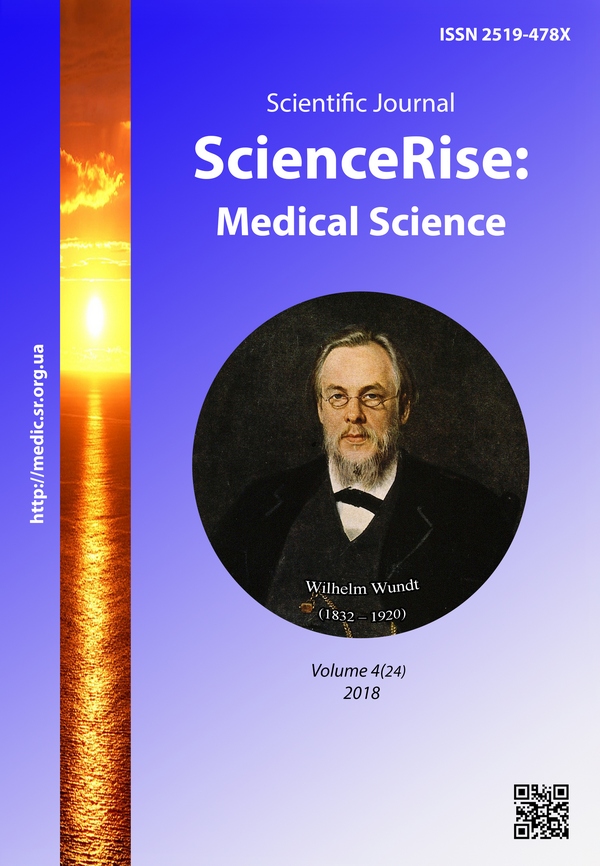Physicochemical and structural features of the structure of enamel of permanent teeth and their hereditary conditionality
DOI:
https://doi.org/10.15587/2519-4798.2018.132700Keywords:
electron-paramagnetic resonance, EPR dosimetry, heredity, twin method, microcrystals, hydroxyapatiteAbstract
Aim. To determine the degree of influence of hereditary factors on the physicochemical and morphofunctional features of tooth enamel as a factor determining caries resistance or susceptibility to the carious process.
Methods. To solve the problem, the degree of hereditary and environmental conditioning of the physico-chemical and structural properties of the enamel of intact and carious teeth was analyzed using the method of electron paramagnetic resonance on teeth removed by indications of a twin sample (30 monozygotic and 30 dizygotic pairs of twins). The method of electron paramagnetic resonance (EPR) allows one to obtain unique information about microscopic and macroscopic properties of tooth enamel, which cannot be obtained with the help of X-ray diffraction, spectral and other analyzes.
Result. We found that the concentration of paramagnetic centers formed after irradiation is generally 1.5-2 times higher in enamel of carious teeth than in intact ones. The value of K, which characterizes caries susceptibility, is most pronounced when comparing the concentration of free radicals in the enamel of intact and carious teeth; incisors on the vestibular surface (1.35), in molars in the cervical region (1.97). As is known, the radiation resistance of solids can be characterized by the concentration of paramagnetic centers formed after irradiation. This stability, in turn, is related to the structure, chemical composition, strength of chemical bonds. Analysis of the results of twin studies showed that the intraparity differences in the concentration of free radicals of the F-center of the corresponding parts of the enamel of teeth in monozygotic pairs were significantly lower (1.6) than in identical sites of dizygotic twin pairs (7.0). High values of the heritability index (H-0.81) give grounds for making a conclusion about the significant contribution of hereditary factors to the indicator under study
Conclusions. The physico-chemical and morphological properties of the enamel determine the susceptibility or stability of the teeth to carious lesions and experience a high degree of hereditary influences (H-81, H-0.95). Based on the data obtained, it can be concluded that the structure of the enamel is genetically determined. This indicates the need for an individual approach to the implementation of preventive measures with the allocation of risk groups to tooth decay
References
- Cevc, G., Cevc, P., Schara, M., SkaleriC, U. (1980). The caries resistance of human teeth is determined by the spatial arrangement of hydroxyapatite microcrystals in the enamel. Nature, 286 (5771), 425–426. doi: 10.1038/286425a0
- Skaleric, U., Ravnik, C., Cevc, P., Schara, M. (1982). Mirocrystal Arrangement in Human Deciduous Dental Enamel Studied by Electron Paramagnetic Resonance. Caries Research, 16 (1), 47–50. doi: 10.1159/000260575
- Temirbaev, M. A., Pivovarov, S. P. Rukhin, A. B., Seredovina, T. A., Sushkova, N. S. (2017). Metodika izucheniya obraztsov emali intaktnykh zubov dlya eksperimental'nogo izucheniya vozmozhnostey EPR-doziometrii v Q-diapazone. Vestnik AGIUV, 4, 54–61.
- Opal, S., Garg, S., Jain, J., Walia, I. (2015). Genetic factors affecting dental caries risk. Australian Dental Journal, 60 (1), 2–11. doi: 10.1111/adj.12262
- Gadaeva, M. V. (2015). Kliniko-eksperimental'noe obosnovanie ispol'zovanie medikamentoznykh skhem lecheniya flyuoroza zubov. Nizhniy Novgorod, 190.
- Glikman, M. L. (1978). Rol' nasledstvennosti v etiologii kariesa zubov. Riga, 28.
- Bretz, W. A., Corby, P., Schork, N., Hart, T. C. (2003). Evidence of a contribution of genetic factors to dental caries risk. Journal of Evidence Based Dental Practice, 3 (4), 185–189. doi: 10.1016/j.jebdp.2003.11.002
- Demner, L. M., Sharafutdinova, A. G. (1984). Rol' nasledstvennosti i sredy v formirovanii zubolitsevykh anomaliy. Stomatologiya, 56 (3), 42–46.
- Pearn, J., Gage, J. (1987). Genetics and oral health. Australian Dental Journal, 32 (1), 1–10. doi: 10.1111/j.1834-7819.1987.tb01265.x
- Gulenko, O. V. (2016). Geneticheskaya determinatsiya kariesa zubov u detey s vrozhdennymi porokami razvitiya TSNS (literaturnyy obzor). Uspekhi sovremennoy nauki i obrazovaniya, 3 (6), 57–63.
- Taktarov, V. G.; Yanushevich, O. O. (Ed.) (2009). Meditsinskaya i klinicheskaya genetika dlya stomatologov. Moscow: GEOTAR-Media, 400.
- Bretz, W. A., Corby, P. M., Schork, N. J., Robinson, M. T., Coelho, M., Costa, S. et. al. (2005). Longitudinal Analysis of Heritability for Dental Caries Traits. Journal of Dental Research, 84 (11), 1047–1051. doi: 10.1177/154405910508401115
Downloads
Published
How to Cite
Issue
Section
License
Copyright (c) 2018 Philip Savransky, Svetlana Chigarina, Petr Grishin, Roman Simakhov, Maxim Khaikin, Elena Kalinnikova

This work is licensed under a Creative Commons Attribution 4.0 International License.
Our journal abides by the Creative Commons CC BY copyright rights and permissions for open access journals.
Authors, who are published in this journal, agree to the following conditions:
1. The authors reserve the right to authorship of the work and pass the first publication right of this work to the journal under the terms of a Creative Commons CC BY, which allows others to freely distribute the published research with the obligatory reference to the authors of the original work and the first publication of the work in this journal.
2. The authors have the right to conclude separate supplement agreements that relate to non-exclusive work distribution in the form in which it has been published by the journal (for example, to upload the work to the online storage of the journal or publish it as part of a monograph), provided that the reference to the first publication of the work in this journal is included.









